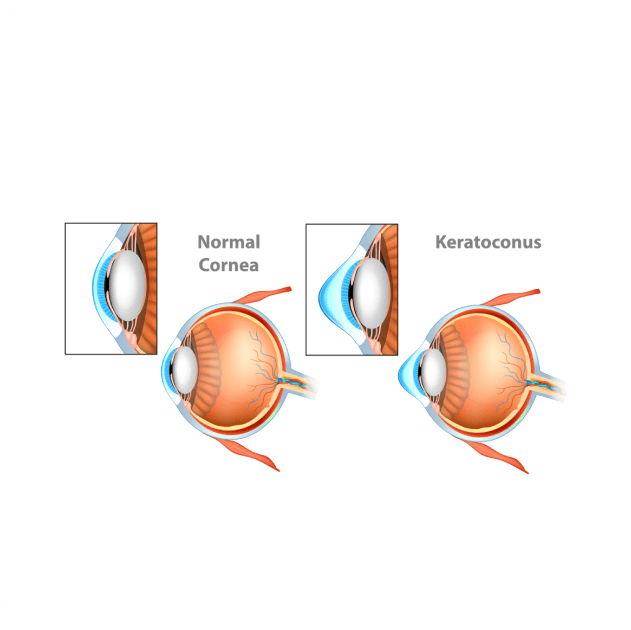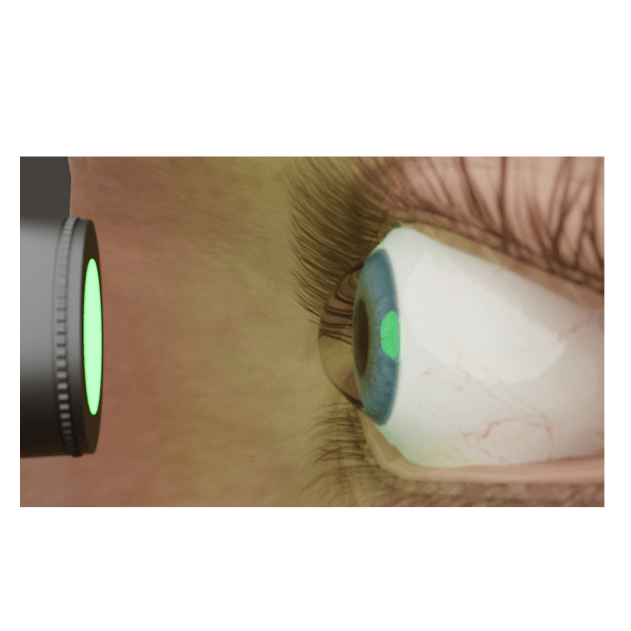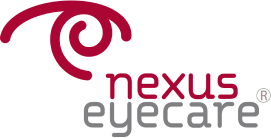
What is Keratoconus?
Keratoconus is an eye condition where the front part of your eye, called the cornea, becomes thin and starts to bulge outward like a cone. This change in shape can lead to blurry vision and increased sensitivity to light and glare. It typically affects both eyes.
As Keratoconus gets worse, the signs and symptoms can also get worse and change over time. Some common symptoms to look out for include:
- Blurry vision
- Double vision
- Clouding of vision
- Eye strain and pain
- Headaches
- Sensitivity to light and glare
- Seeing halos or ghosting
- Need for frequent changes in glasses prescriptions
Although the corneal damage caused by keratoconus cannot be reversed, there are treatments available to help slow down its progression and improve vision. Depending on your symptoms and the stage of your disease, your ophthalmologist
may recommend one of the following corneal disease treatments:
Prescription glasses: These are specially designed glasses that can help correct your vision and provide clearer eyesight.
Contact lenses: Special contact lenses, such as rigid gas permeable (RGP) lenses or scleral lenses, can be used to improve vision and provide better corneal support.
Corneal ring segments: These are small, clear plastic rings that are placed in the cornea to help flatten its shape, improving vision.
Corneal collagen cross-linking: This is a procedure that strengthens the cornea using a combination of riboflavin eye drops and ultraviolet light. It can help stabilise the cornea and prevent further bulging.
Remember, the choice of corneal disease treatment depends on your individual case, so it's important to consult with your ophthalmologist to determine the most suitable option for you.
- Eye rubbing
- Age
- Race
- Family history
- Medical conditions
- Inflammation
What is Collagen Cross-Linking?
CXL (Collagen Cross-Linking) is a procedure done in an office setting to strengthen the cornea. It involves using a special UV light and riboflavin (vitamin B2) eye drops. During the procedure, the UV light creates bonds between collagen fibers in the cornea, making it stronger and more stable.
CXL is important because it is the only treatment that can prevent keratoconus from getting worse. If left untreated, keratoconus can severely damage the cornea and may require a cornea transplant surgery, which is a major surgery. CXL can stop the progression of keratoconus in about 95% of people.
During the collagen cross linking treatment, your eyes will be numbed with eye drops. The surface layer of the cornea is removed, and riboflavin eye drops are applied. After the drops have soaked in, the cross-linking process begins with UV light and more riboflavin eye drops. A bandage contact lens is then placed on the eye to protect it while it heals.
It’s important to note that CXL doesn’t improve vision or replace the need for glasses or contact lenses. Its primary goal is to stop the progression of keratoconus and maintain the stability of the cornea.

CXL treatment is suitable for people whose keratoconus is progressing, meaning the condition is getting worse over time. Only your eye specialist can determine if you need this cornea damage treatment and which eye needs it the most.
It's important to know that CXL doesn't reverse the effects of keratoconus; it only slows down the condition and prevents it from getting worse. If you have a family history of keratoconus or certain medical conditions like Ehlers-Danlos syndrome, Down syndrome, retinitis pigmentosa, or osteogenesis imperfecta, you may be prone to keratoconus.
People with hay fever, asthma, eczema, or allergic eye disease are also at higher risk because they tend to rub their eyes, which can worsen keratoconus. If you suspect you have keratoconus or have a family history of the condition, don't delay getting your eyes checked by an eye specialist. Early diagnosis and timely corneal disease treatment can prevent further complications.
- Avoid wearing eye makeup on the day of the procedure.
- Have a light meal and stay hydrated.
- Arrange for someone to drive you home after the procedure. It's important not to drive yourself for the first few days.
- Understand and follow the post-op care instructions given to you by your doctor.
CXL treatment is done one eye at a time. If you have keratoconus in both eyes and need CXL treatment, your doctor will decide when to treat the second eye. They will determine the best timing for each eye.
After the CXL procedure, the main goal is to prevent the worsening of keratoconus rather than improving vision. The procedure does not typically lead to a significant improvement in vision. In most cases, patients still need to use prescription glasses or contact lenses to correct their vision even after the CXL procedure.
After the CXL procedure, you may experience slight irritation, a grainy feeling, and watering in the treated eye. Pain is common for the first 24-48 hours but should subside. To prevent dryness, you will need to use tear lubricants for a few months. Serious side effects such as corneal scars, infections, or haze are extremely rare.
After the CXL procedure, you will need to see your eye doctor a few times for check-ups. They will examine your treated eye a few days after the treatment, then again after one week. After that, you'll have follow-up appointments at 4 weeks, 3 months, 6 months, 1 year, and 2 years. These appointments help your doctor monitor how you're doing and make sure the treatment is working well for you.

